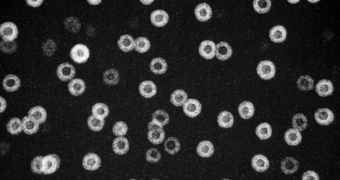Back in 2006, researchers in the United States first created a remarkable alloy containing aluminum, scandium and lithium. Now, the same team managed to use advanced observations methods to figure out that nanoparticles are largely responsible for the amazing properties this material has.
One of the most interesting aspects of metallurgy is that this field of science has been using nanoscale particles unknowingly for more than a century. However, it wasn't until a couple of decades ago that this was found out, and further researched.
Creating alloys that contain nanoparticles is achieved by a variety of means, which usually include heating a chemical mixture to a certain temperature, and then cooling it rapidly. This leads to the precipitation of desirable nanoscale particles in various matrix patterns.
The size, shape, stability and uniformity of the newly-developed nanoparticle are absolutely essential to the strength of the finished alloys. As such, their properties can be fine-tuned by tweaking any of these factors in the production process.
The alloy that researchers at the US Department of Energy's (DOE) Lawrence Berkeley National Laboratory (Berkeley Lab) developed back in 2006 features a particular formulation of aluminum, scandium, and lithium. This mixture has tremendous chemical and physical properties.
Berkeley Lab Materials Sciences Division investigators Velimir Radmilović and Ulrich Dahmen – who created the alloy in the first place – recently took a look at the material by using the Berkeley Lab National Center for Electron Microscopy's (NCEM) TEAM microscope.
The instrument's capabilities were augmented using atom-probe tomography and other experimental techniques, as well a mathematical models and theoretical studies. This combined approach revealed how the nanoparticles inside the alloy form, and what chemicals they contain.
Apparently, these small-scale constructs develop scandium-rich cores, which are enveloped in lithium-rich shells. These structures then spread out uniformly throughout a complex aluminum matrix.
“With the TEAM microscope we were able to study the core-shell structure of these nanoprecipitates and how they form spheres that are nearly the same in diameter,” explains Dahmen, who holds an appointment as the director of NCEM.
“What’s more, these particles don’t change size over time, as most precipitates do,” adds the researcher, who is also an author of a new study describing the findings. The paper is published in a recent issue of the top scientific journal Nature Materials.
“Typically, small particles get smaller and large particles get larger, a process called ripening or coarsening, which eventually weakens the alloys. But these uniform core-shell nanoprecipitates resist change,” he goes on to say.
Radmilović says that scandium does not easily precipitate. As such, the entire mixture needs to be heated near its boiling point in order for the nanoscale particles to develop.
“Scandium is the most potent strengthener for aluminum. Adding less than one percent scandium can make a dramatic difference in mechanical strength, fracture resistance, corrosion resistance – all kinds of properties,” he adds.
Radmilović also holds an appointment at NCEM, and is a professor of metallurgy at the University of Belgrade, in Serbia. He is an author of the Nature Materials paper as well. The DOE Office of Science provided the bulk of funding for this research.

 14 DAY TRIAL //
14 DAY TRIAL //